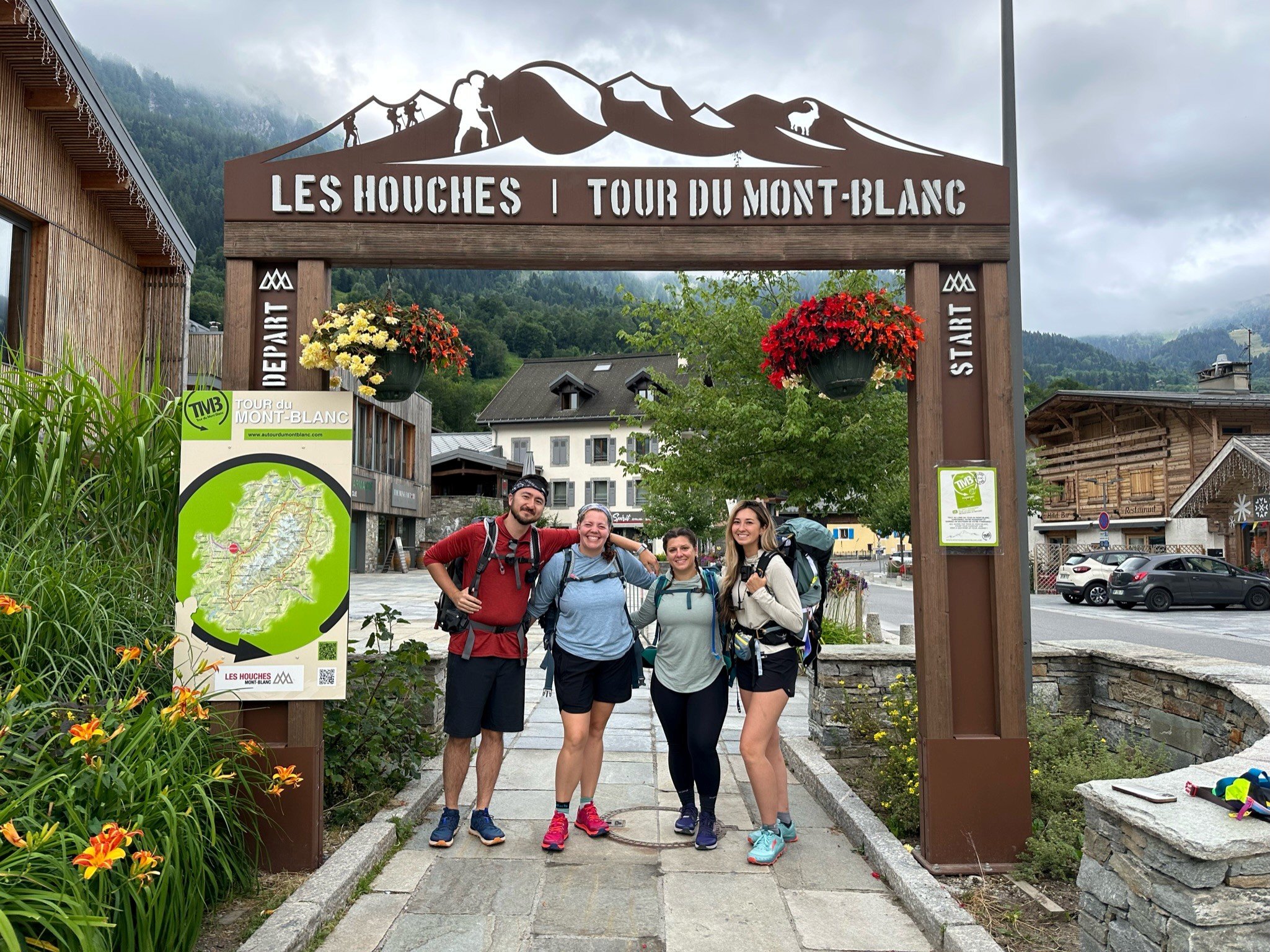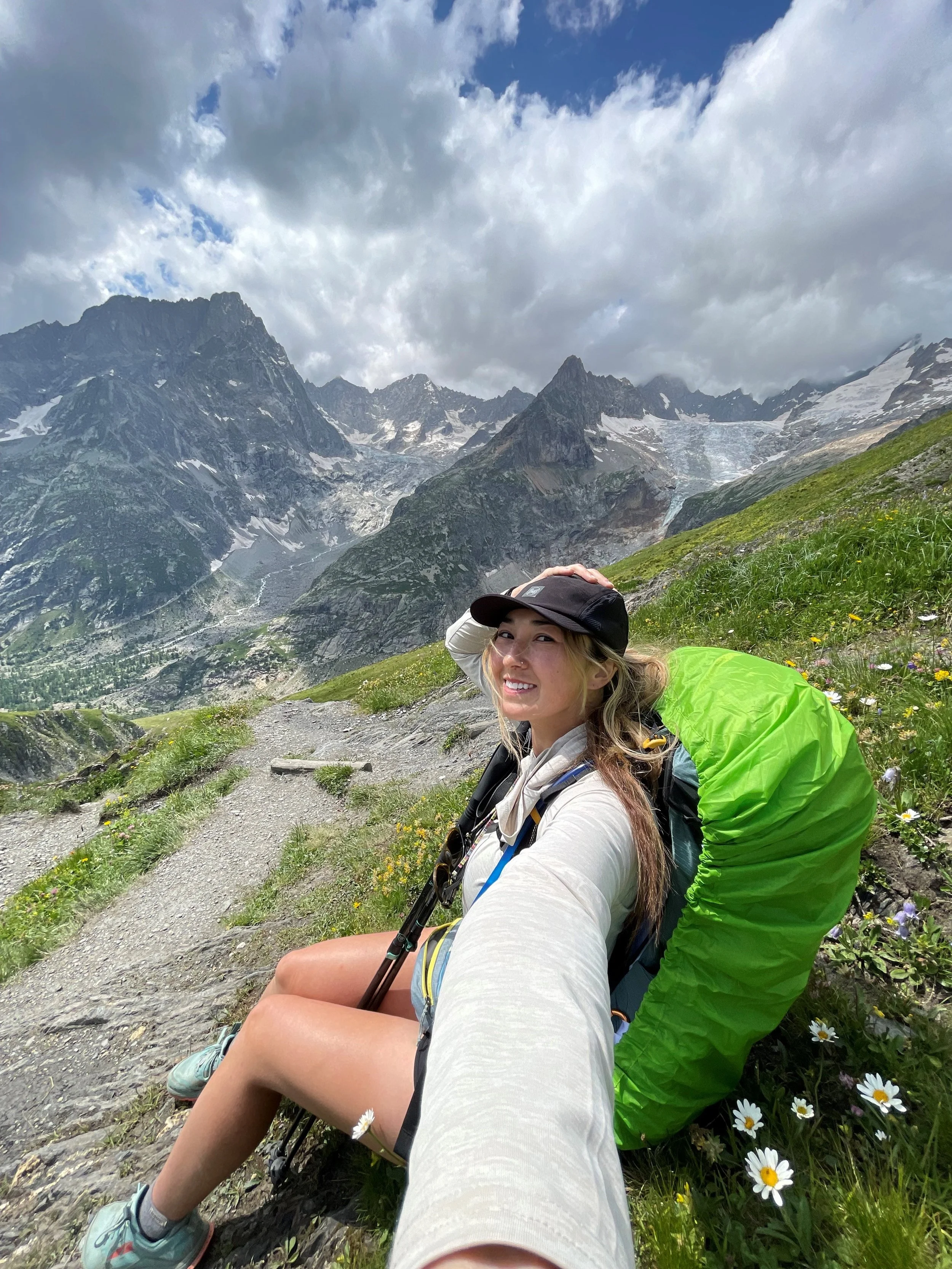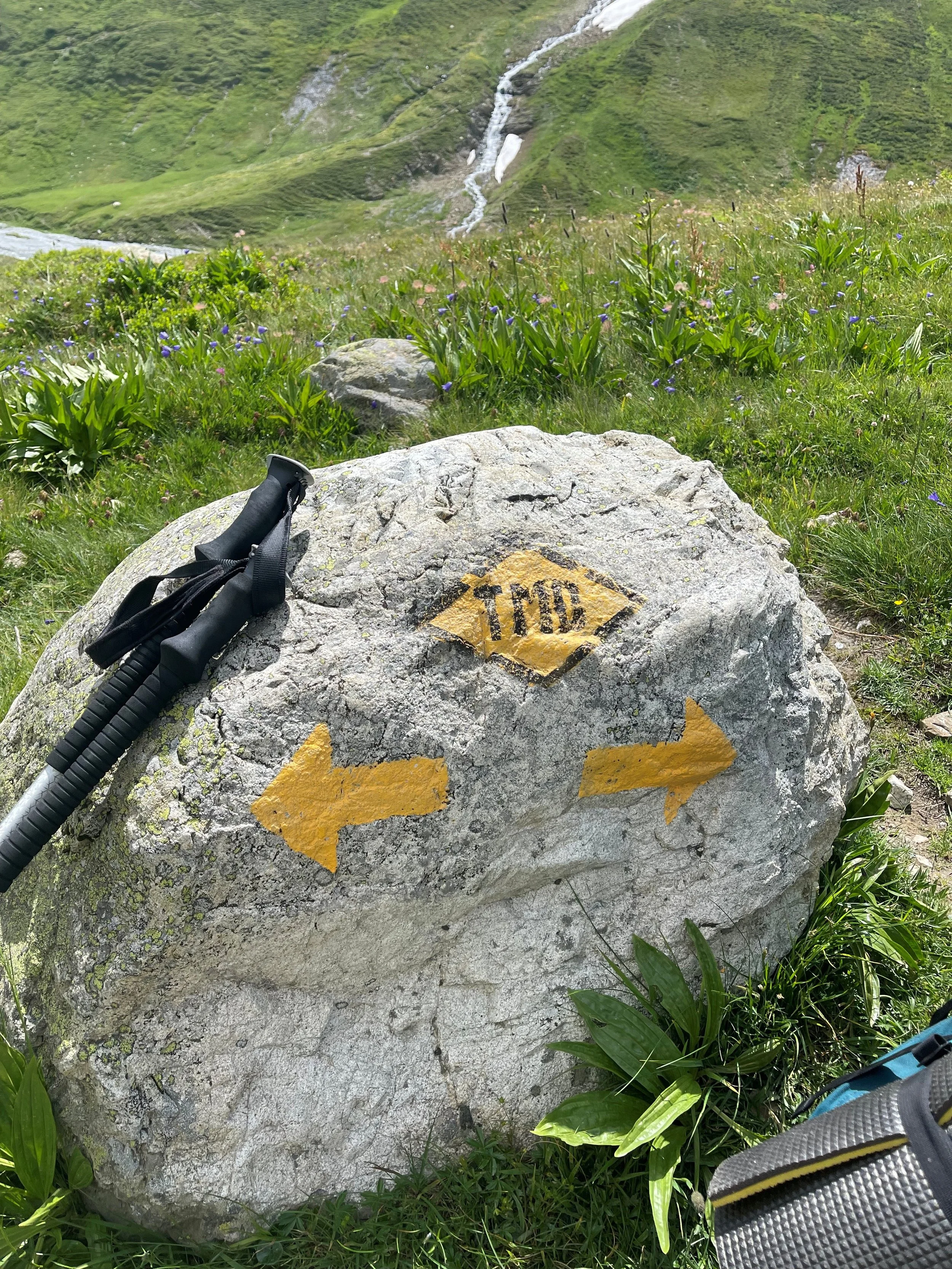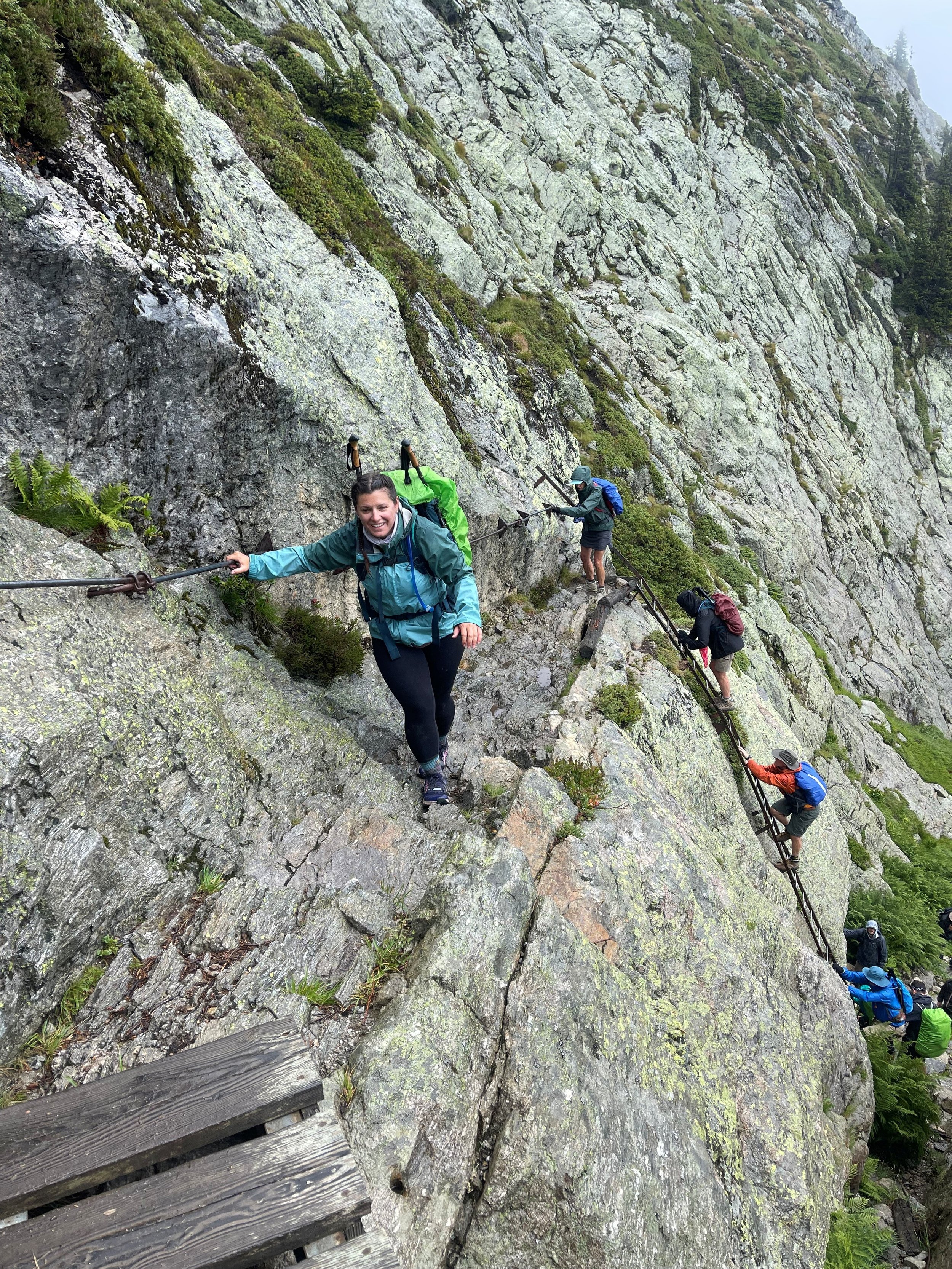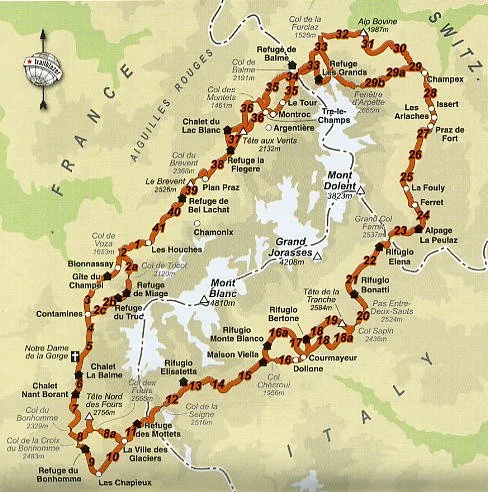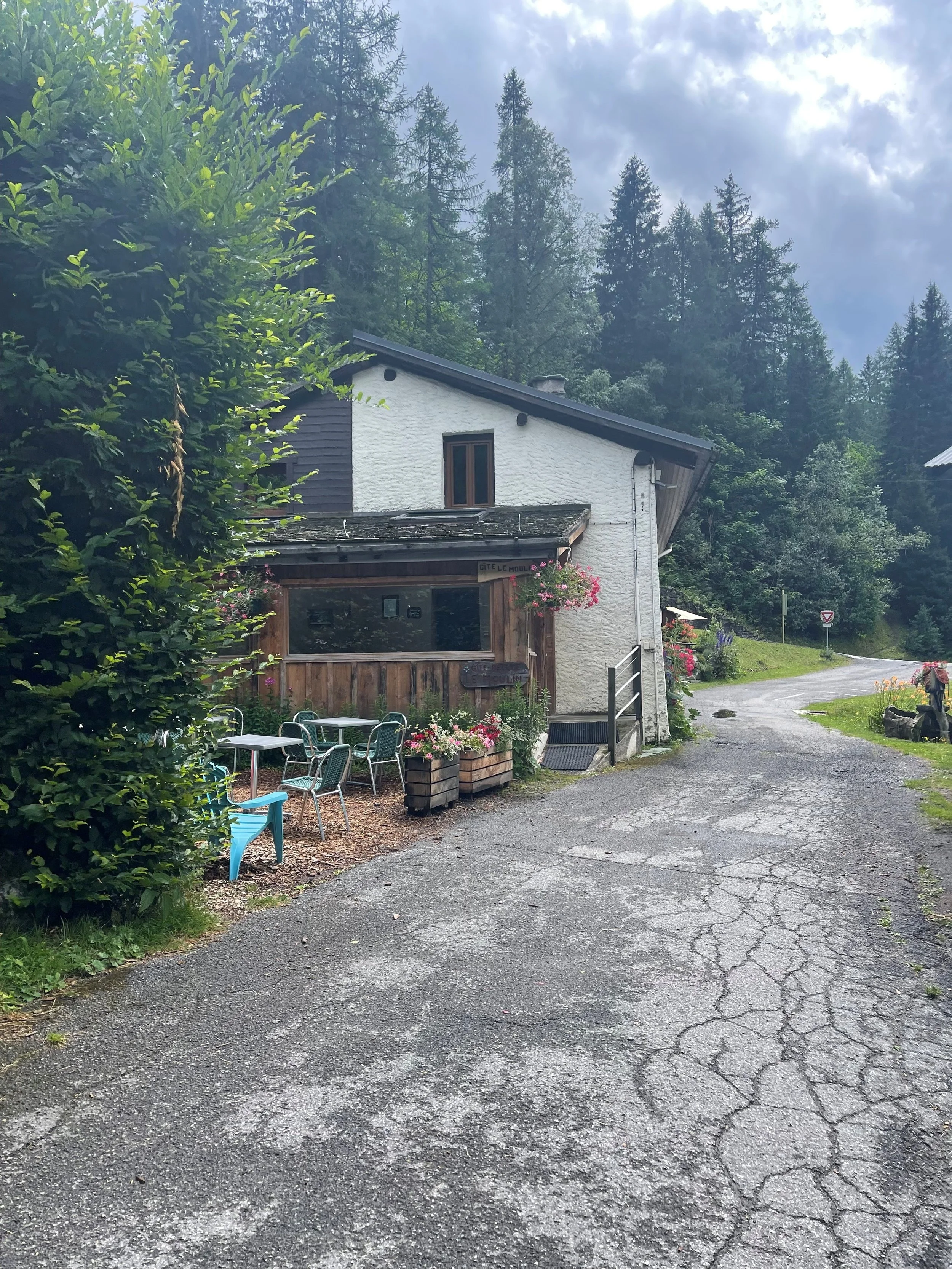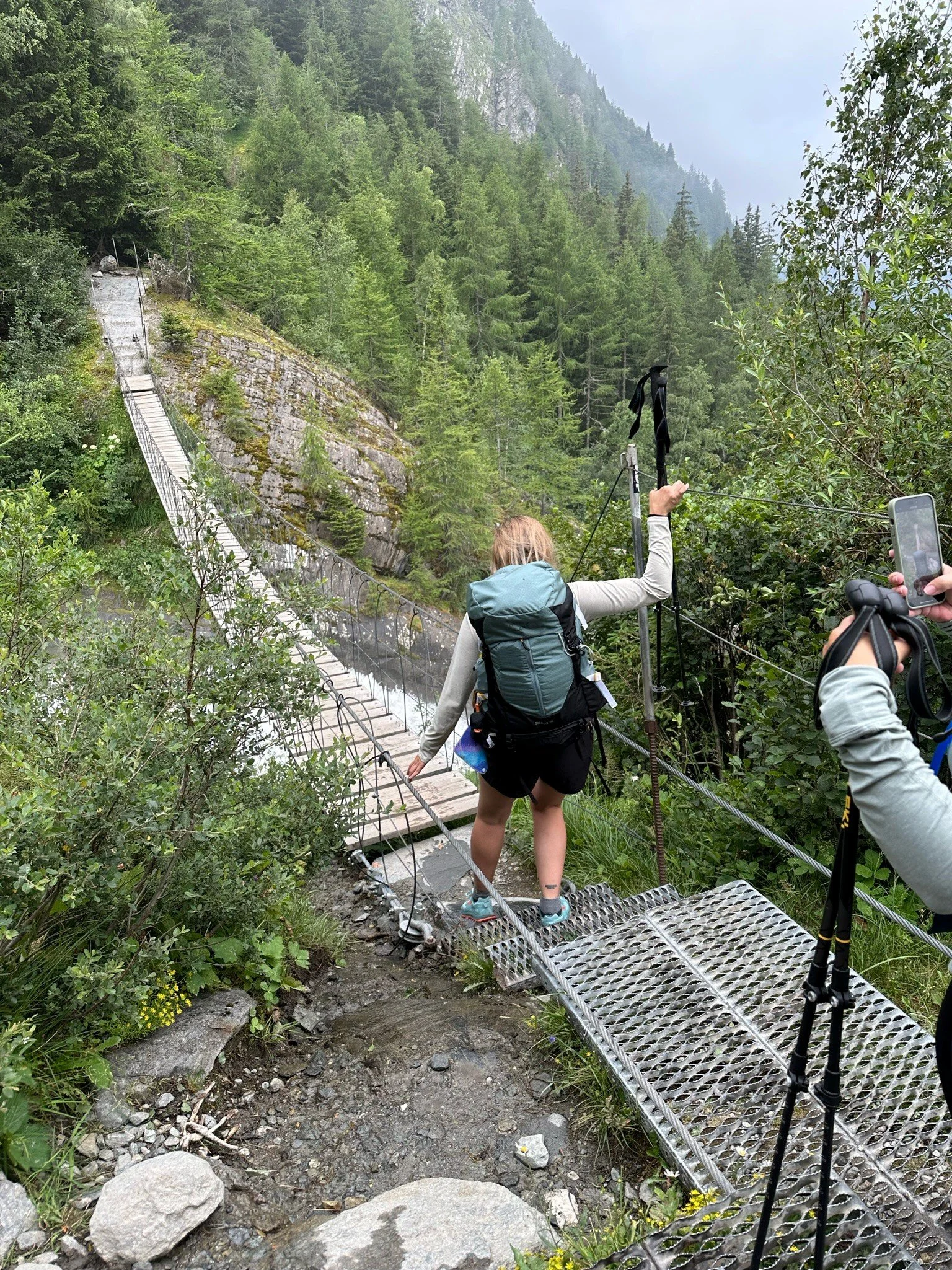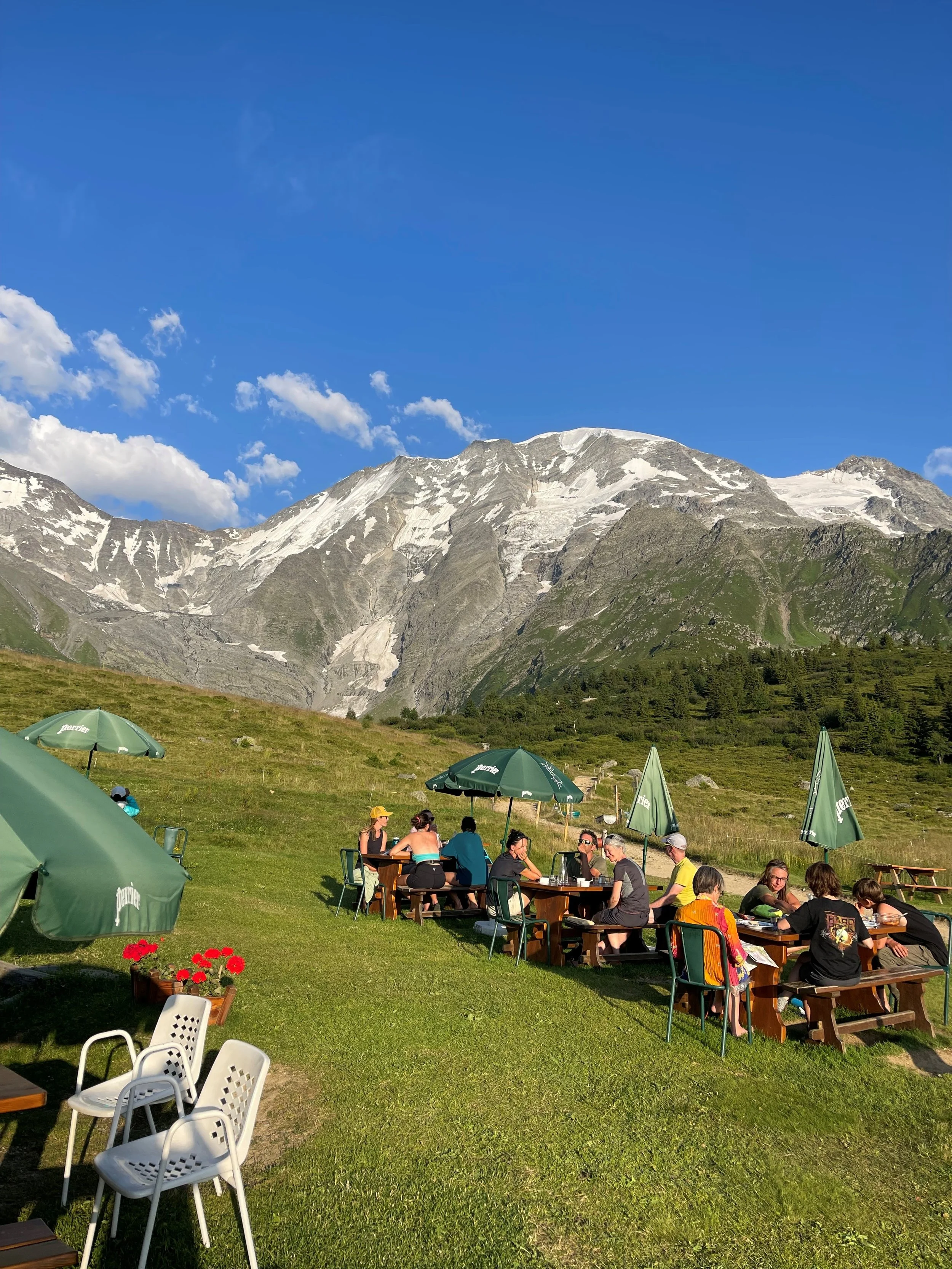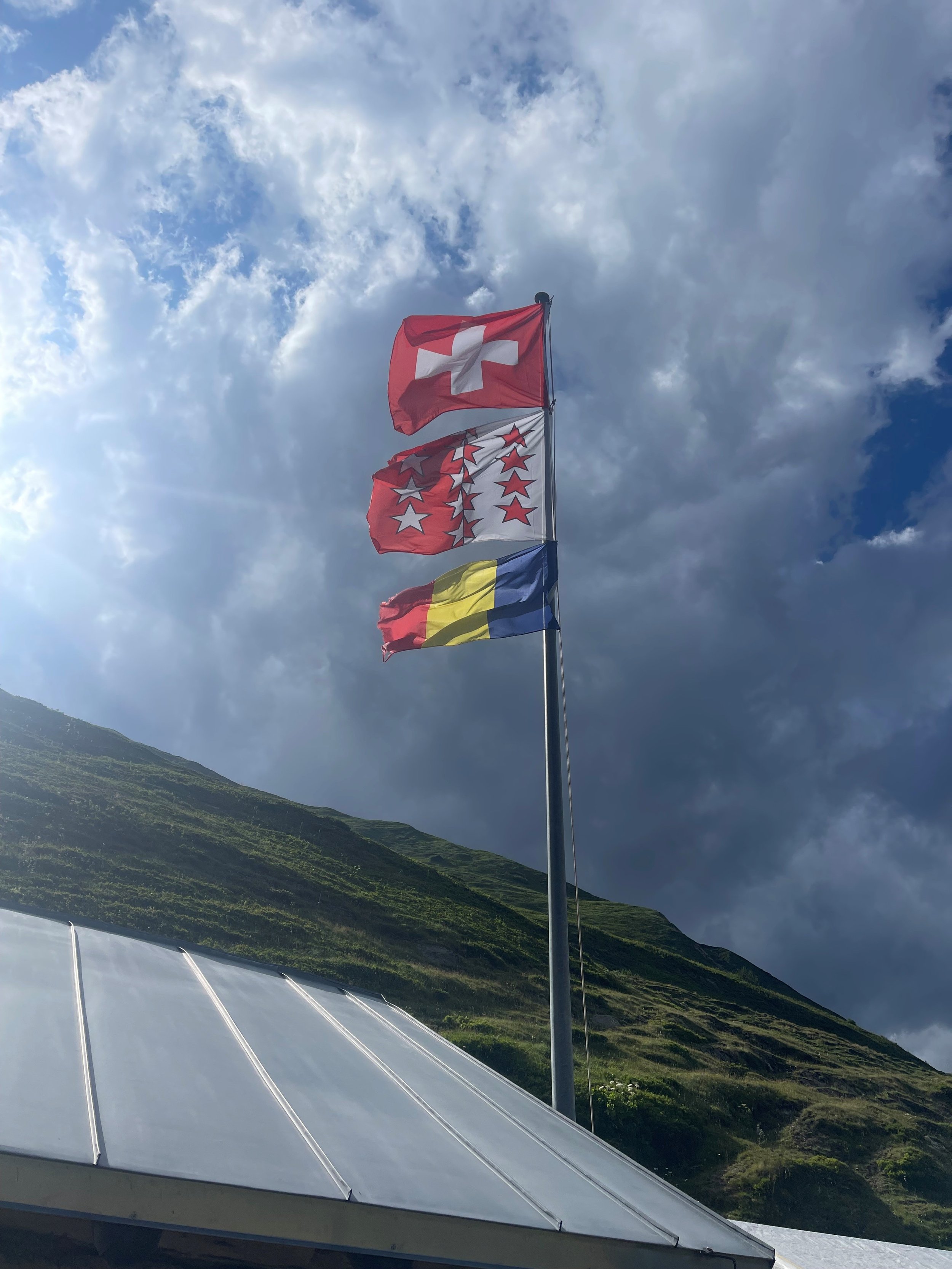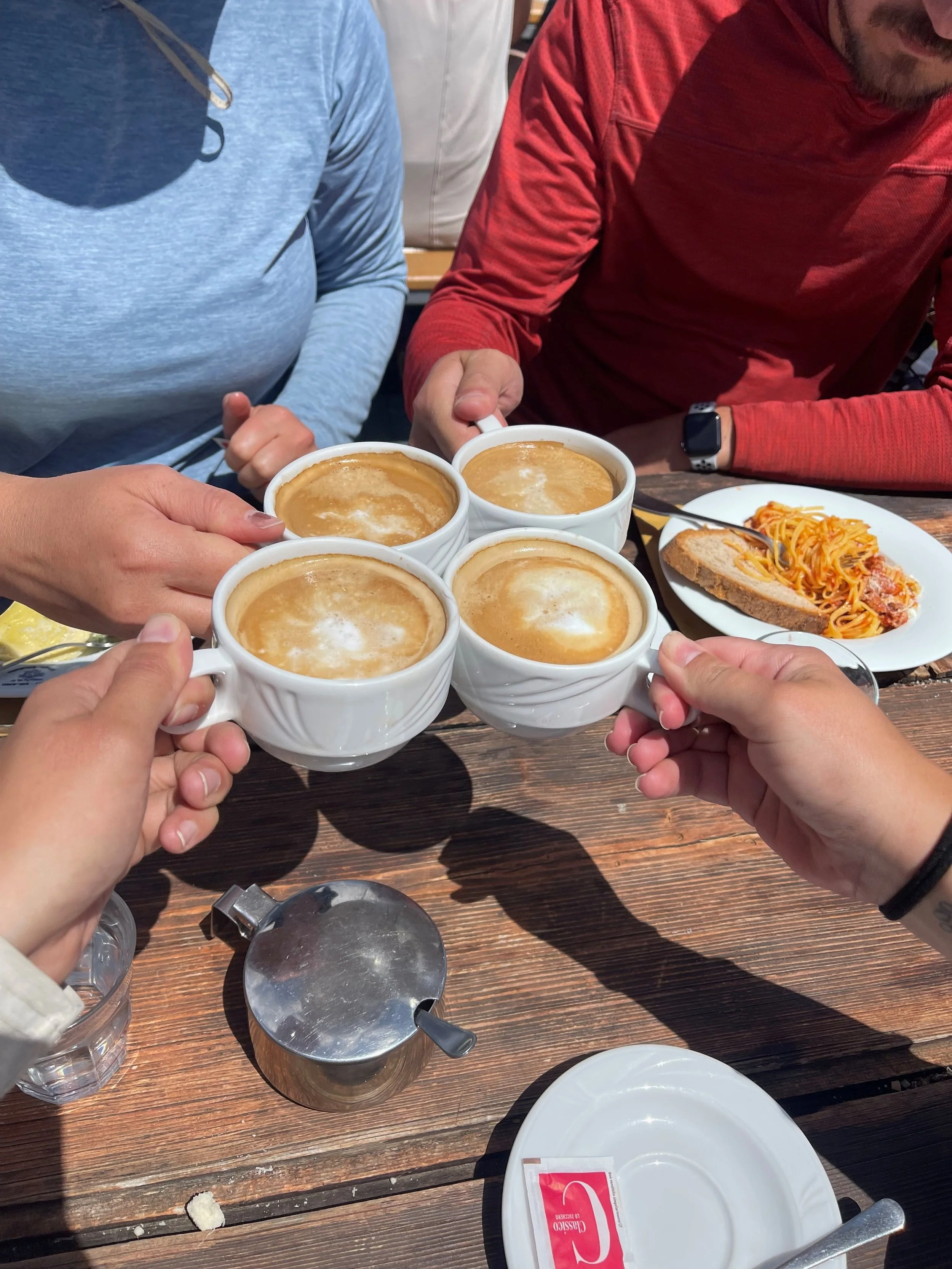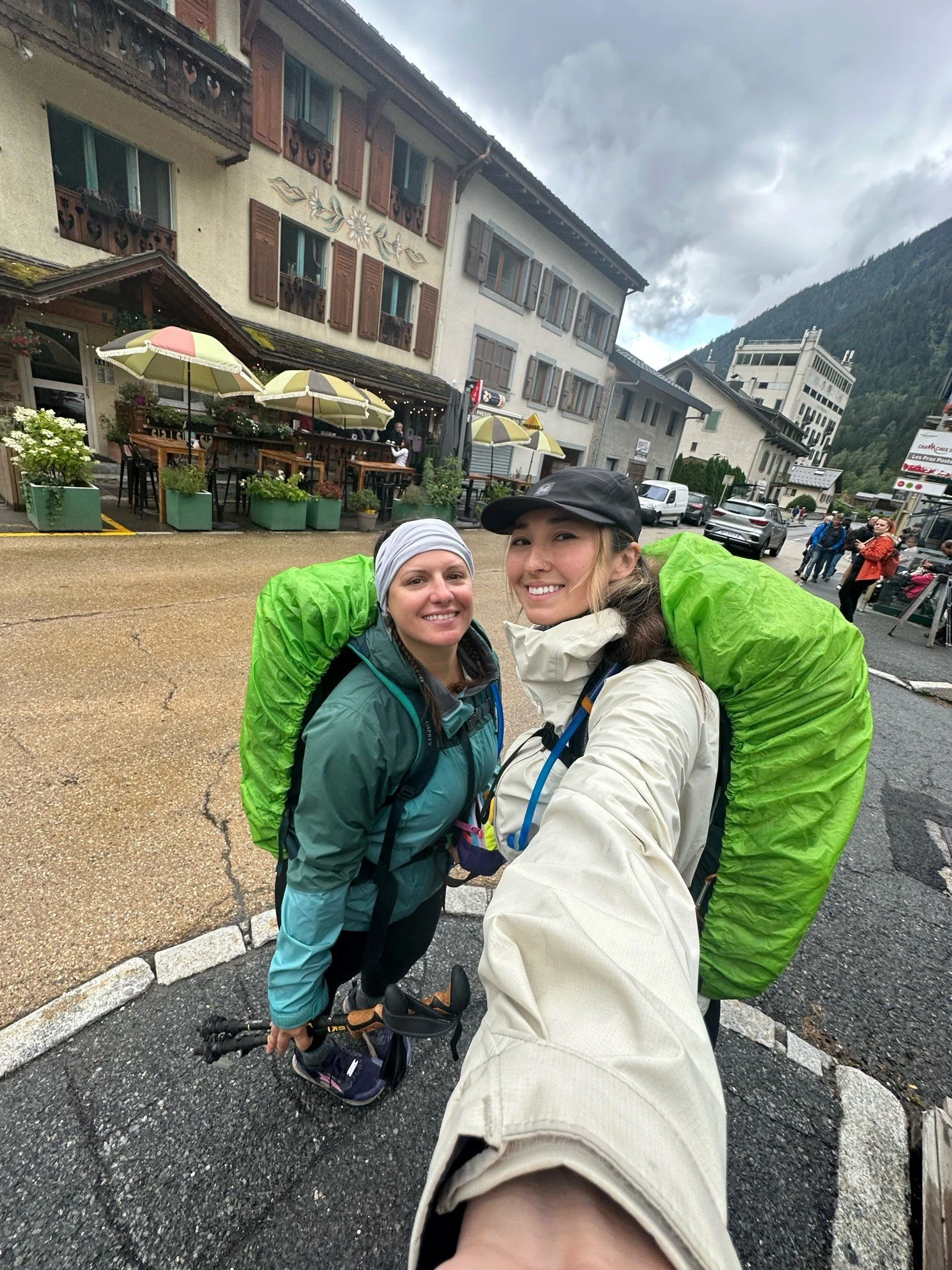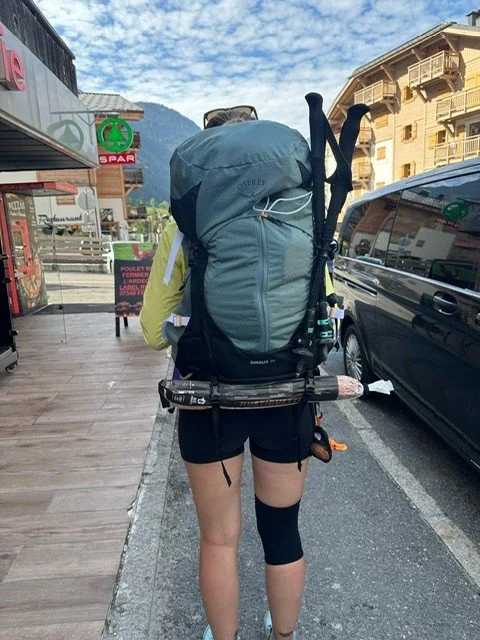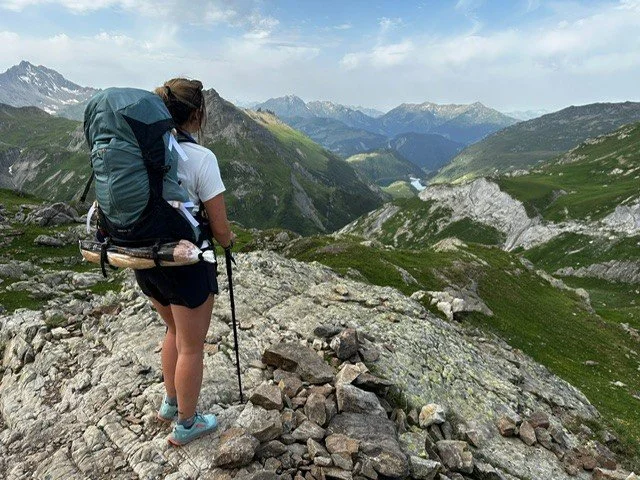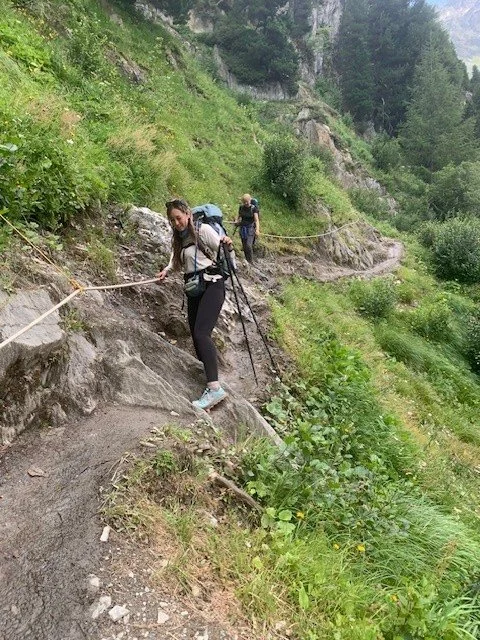A Complete Guide to Hiking the Tour Du Mont Blanc
I first stumbled across the Tour du Mont Blanc on a random social media post, a quick video of hikers weaving through wildflower-filled meadows with snow-dusted peaks towering above. Within minutes I was hooked. By the end of the month, our plans were set for the following summer. The Tour du Mont Blanc (TMB) is one of Europe’s most iconic long-distance treks, circling the Mont Blanc massif over roughly 105 miles (170 km). Over the course of 10–12 days, you travel hut-to-hut through three countries — France, Italy, and Switzerland — tracing alpine valleys, climbing over breathtaking mountain passes, and unwinding each night in cozy refuges stocked with hearty meals and new friends. It’s equal parts adventure and comfort, and a journey that blends rugged landscapes with a cultural experience you won’t find anywhere else.
Difficulty: Moderate-Difficult
Distance: 166km / 103mi
Duration: ~ 10 days
Highest point: 2,526m / 8,287 ft
Total elevation gain: 10,000m / 32,700 ft
How to Hike Tour du Mont Blanc
Most people tackling the Tour du Mont Blanc sign up for some sort of package, either a fully guided group or a “self-guided” plan where someone else lays out every step for you. They’re everywhere, and they don’t come cheap. Prices ranged from about a thousand dollars to well over five grand (and that’s before you even book your huts). A few companies will even shuttle your bag from refuge to refuge so you can just carry a daypack! That’s great for some, but it wasn’t what we personally wanted out of this trek.
From the start, we knew we wanted to hike the whole TMB on our own and not having to stick to a schedule someone else built. Part of the adventure, for us, was being free to stop when a view begged for a long break or keep moving if the weather looked dicey. I trusted our group to figure it out, and honestly, with a good map and guidebook, this is an incredibly easy trail to follow. Planning it ourselves meant every step, every pass, and every hut stop was ours to choose and that made the journey so much better.
Best Time to Hike the TMB
For the Tour du Mont Blanc, most people agree the prime hiking window runs from mid-July through mid-September. We tackled the trail in late July and found steady crowds in the more popular spots, but nothing overwhelming. Early to mid-September can be a particularly lovely time: the weather is often drier and more stable than in July or August, though the days grow noticeably shorter as the season winds down.
If you’re planning to stay in the mountain huts, book ahead for July and August since they tend to fill quickly. By mid-September, several huts start closing for the season, but those still open are often easier to reserve.
Is it Safe to Hike as a Solo Hiker?
Absolutely! Hiking the Tour du Mont Blanc without a guide is not only possible, it’s what most people do. I didn’t hike the entire route solo myself, but I did set out independently and even joined a separate group I met on the trail for one of the variants. They were wonderful, as are most people you’ll meet along the way.
In the busy summer months, hiring a mountain guide usually isn’t necessary unless you want the extra support or insight they provide. The trail is well-trafficked, and most sections have cell phone coverage. Even after a long, challenging day, you’ll often find yourself arriving at a viewpoint or parking area full of day-hikers and families, you’re rarely far from other people.
Mountain huts felt very safe, with welcoming staff, friendly hikers, and alpinists swapping stories over coffee, wine, or espresso. Many shared tips about the Haute Route or the history of their hut and surrounding peaks.
Navigation is straightforward: most of the route is marked with red-and-white stripes for standard trails and blue-and-white for more technical sections, along with clear signs pointing to the next stop and showing estimated hiking times. (Unlike in the states, these times in Western Europe tend to be quite accurate for a moderately fast hiker.) A GPS map on your phone is handy if you want extra reassurance.
People along the way are warm and helpful, and many speak multiple languages — so even if you’re an English-only traveler, you shouldn’t have trouble communicating.
How Difficult is it to Hike the TMB?
Embarking on the Tour du Mont Blanc (TMB) is a journey that challenges both body and mind. From my experience, I'd classify the trek as moderate to difficult, depending on your fitness level, hiking experience, and the route you choose.
One of the best things about the TMB is how flexible it is. Some days, the climbs are long and your legs are screaming, but you can always take a chairlift, cable car, or bus to save energy. Want to make it harder? Take a slightly more challenging variant route. Want to take it easy? Stick to the main trail and soak in the scenery. I saw hikers of all ages, shapes, and fitness levels completing this trek, the real secret is just having the mindset to keep putting one foot in front of the other.
Also just knowing that a cozy mountain hut and a warm meal are waiting for you at the end of the day was a huge motivator for me! Nothing like swapping stories with fellow hikers over a big plate of pasta and a hot shower after a tough day on the trail. It’s not just hiking; it’s a mix of adventure, comfort, and social time rolled into one.
So yeah, it’s a challenge, but it’s also so much fun. The TMB lets you test yourself physically while still enjoying all the comforts and little pleasures along the way. If you love hiking, love a good view, and don’t mind a few sore legs, this is a trail you can absolutely do and trust me, you’ll feel amazing when you finish!
Logistics
One of the smoothest and most budget-friendly ways to start the Tour du Mont Blanc is by flying into Geneva Airport (GVA). Many international airlines fly into Geneva, and it’s often the most convenient hub for reaching Chamonix and the surrounding French Alps.
Flying into Geneva
Flights into Geneva are usually frequent and competitively priced, especially if you book in advance or fly mid-week. Since Geneva sits just across the French border, it’s a perfect launch point for anyone beginning the TMB in France.
Shuttle from Geneva to Chamonix
From Geneva Airport, we booked a shuttle service, one of several companies that run hourly or near-hourly transfers between the airport and Chamonix Valley.
Cost: We paid less than $100 USD per person, which covered the roughly 1 hour 30 minute ride.
Convenience: The shuttle dropped us right near our chosen hut in Chamonix, saving us the hassle of changing buses or walking with heavy packs.
Tip: Shuttles are especially worth it if you have early or late flight arrivals, or if you’re carrying a lot of hiking gear.
If you’re on a very tight budget, you could take a combination of public buses and trains, but it typically requires more time and transfers. The shuttle’s door-to-door service was well worth the small extra cost.
Staying in Chamonix
We opted to stay two nights in Chamonix before starting the trail. This gave us a chance to:
Rest and recover from our flights
Pick up any last-minute gear or supplies
Enjoy the atmosphere of this lively alpine town
We stayed in one of the many hostels in Chamonix, which was clean, social, and affordable, a great base for hikers.
Public Bus from Chamonix to Les Houches
When we were ready to hit the trail, we used the local public bus that connects Chamonix to Les Houches, the classic starting point for the TMB.
Cost: Just a few euros each way
Frequency: Buses run regularly throughout the day in the summer hiking season
Travel Time: The ride takes about 20 minutes
This was by far the easiest and most affordable way to get to the trailhead without worrying about parking or hiring a taxi.
Route and Itineraries
The Tour du Mont Blanc is famous for being flexible: you can tweak almost every part of the hike to suit your time, fitness, desired remoteness, lodging style, and how much scenery and adventure you want. Here are the main ways people plan their route, with perks and trade-offs, plus popular variants.
Map of the TMB Route
Direction: Clockwise vs Counter-Clockwise
Where you start (Les Houches, Chamonix, Courmayeur etc.) and whether you go clockwise or counter-clockwise makes a difference.
The most popular route is to do the TMB anti-clockwise (starting in Les Houches) because the climbs tend to feel more gradual earlier in the hike, making the acclimatization a bit easier.
Clockwise is less popular, but it has its perks, maybe fewer early crowds in some sections, or a different perspective on sweeping views of Mont Blanc’s southern faces. The challenge is that some climbs might hit you when you’re still fresh/heavy-legged.
Suggested Itinerary: 10 Days Around Mont Blanc
The TMB can be hiked in 7–12 days, but here’s our 10-day itinerary:
Stage 1: Les Houches → Auberge du Truc
Distance: 14.8 km
Ascent/Descent: +1410 m / –700 m
Highlights: Col de Voza views, glacier bridge crossing, beautiful hut stay. However, no Electricity.
Stage 2: Auberge du Truc → Refuge de La Balme
Distance: 9.5 km
Ascent/Descent: +788 m / –960 m
Highlights: Notre Dame de la Gorge chapel, valley views.
Stage 3: La Balme → Refuge des Mottets
Distance: 19.9 km
Ascent/Descent: +1340 m / –930 m
Highlights: Col de Bonhomme, transition toward Italy, sweeping panoramas. Hut had great entertainment. We were able to share a private room (4 beds)
Stage 4: Mottets → Rifugio Maison Vieille (Italy)
Distance: 18 km
Ascent/Descent: +1070 m / –990 m
Highlights: Crossing the Col de la Seigne into Italy, Lake Combal.
Stage 5: Maison Vieille → Rifugio Gio Bertone
Distance: 9.5 km
Ascent/Descent: +760 m / –770 m
Highlights: Courmayeur, mountaineering history, Mont Blanc’s south face.
Stage 6: Bertone → Gîte Alpage de La Peule (Switzerland)
Distance: 20.7 km
Ascent/Descent: +1090 m / –990 m
Highlights: Col Ferret, Rifugio Bonatti, views of Grand Combin.
Stage 7: La Peule → Relais d’Arpette
Distance: 22.5 km
Ascent/Descent: +680 m / –1090 m
Highlights: La Fouly valley, Lake Champex.
Stage 8: Arpette → Auberge Mont Blanc
Distance: 12–15 km (route options)
Ascent/Descent: up to +980 m / –1340 m
Highlights: Fenêtre d’Arpette (highest pass at 2700 m) or easier Col de Portalo option.
Stage 9: Mont Blanc → Gîte Le Moulin
Distance: 14.6 km
Ascent/Descent: +1090 m / –1020 m
Highlights: Crossing Col de la Balme back into France, views of Aiguille du Chardonnet.
Stage 10: Le Moulin → Chamonix/Les Houches
Distance: 14–24 km (route options)
Ascent/Descent: up to +2040 m / –1660 m
Highlights: Lac Blanc, balcony views of Mont Blanc, celebratory dinner in Chamonix.
Hut Gallery
Variants - “Off-Route” Options
If you want scenic detours, more remote terrain, or want to avoid bad weather or crowds, there are many variants. Some increase technical difficulty; others let you simplify or bypass hard sections.
Here are some of the more popular variants:
Col des Fours – A more remote pass variation that gives wild views, sometimes used to adjust or shorten sections.
Fenêtre d’Arpette – Found between Champex-Lac and Trient. It’s steep, dramatic terrain. Many only do it in good weather.
Lac Blanc & “Ladders” Section – Near the end of the loop (La Flégère / Refuge Lac Blanc), there’s a famous ladder/steep ascent section. Stunning views, but some exposure. My favorite detour or side-trip.
Les Grands Variant – Less traveled, more solitude, high traverses above the tree line (for example over Refuge Les Grands and rejoining near Col de Balme).
Lower-level or easier variants also exist to avoid high passes or steep sections, especially in early season or bad weather.
Can I tent camp instead of staying in huts on the Tour du Mont Blanc?
Yes. Tent camping is possible on the TMB, but it comes with a set of trade-offs, challenges, and legal nuances. For us, while we considered camping, we opted to stay in huts because the hut-to-hut culture, the food, and everything about those refuges are part of what makes the TMB so special. Below is a breakdown of what you should know if you are thinking of camping vs huts, plus why we think huts are still worth prioritizing.
What “camping” means on the TMB
Official campsites: there are formal campgrounds along or near the trail in all three countries (France, Italy, Switzerland). Some have basic facilities (toilets, cold taps), others offer more (hot showers, shops, electricity, etc.).
“Bivouac” or wild camping: lighter version, setting up a non-permanent shelter (a tent) off the trail, often after dusk and breaking camp early. It’s more “shadow camping” than full campsite lifestyle.
Legal & logistical constraints
Legal issues / restrictions:
In France, bivouac is relatively more tolerated – often allowed from sunset to sunrise; but in protected zones (national parks, nature reserves), rules may be stricter.
In Italy, wild camping is generally banned below ~2,500 meters, and many huts (rifugi) strictly forbid tents on their property.
In Switzerland, wild camping is much more tightly regulated or prohibited, especially in the lower elevations and near villages or protected areas. Official campsites are okay.
Carrying extra weight: A tent + sleeping pad + cooking gear, etc., add bulk and weight. Huts remove much of that load because you don’t need to carry so many nights’ worth of gear.
Finding flat/hidden sites: The trail often runs through exposed terrain; flat spots for tenting may be rare, or visible from trails/villages. If wild camping, you’ll need to be stealthy (set up late, break early) and respectful.
Amenities: Showers, cooked meals, communal spaces are all more readily available in huts. If you camp, you may still use some hut services (e.g. just get meals, or pay for showers), but not all huts offer that “meal-only” option; and logistics/timing may make it hard. Food resupply is possible in villages, but you’ll have to plan carefully.
Why huts are special
From our perspective, while camping has its perks, the huts really add something that you’d otherwise miss:
Community & culture: Sharing a communal bunk, eating regional meals prepared by hut keepers, hearing stories from other hikers it’s part of the European alpine tradition.
Ease & lighter pack: Not carrying so many nights of gear makes daily mileage more comfortable. Real comfort when it matters (after a long mountain pass).
Comforts: A hot meal without cooking, showers, refuge from weather, etc. These are not just luxury; for many days on a strenuous hike, they make a big difference.
Thus, even for people who like camping (like us), staying in huts some nights adds richness to the experience.
What we did, and what I’d recommend
We chose huts for all our nights. Some were fully-booked by the time we got there if we hadn’t reserved; meals, social time and sleeping “indoors” felt like part of the soundtrack of the TMB.
If you do want to mix camping and huts (or tent-camp entirely), here are some suggestions:
Plan extra buffer days so that you are not forced into overly long mileage when campsites are far apart.
Research ahead which campsites are open in your season (many are seasonal) and check whether huts offer meals only or allow use of showers even if you’re not staying overnight.
Practice “leave no trace” strictly; wild camping visibility increases risk of complaints or fines.
Be flexible: weather, altitude, and terrain sometimes force you to change plans.
What is it like staying in a mountain hunt?
One of my favorite parts of hiking the Tour du Mont Blanc was the experience of staying in the mountain refuges. They’re nothing like the huts you might find in North America. Think of them as a mix between rustic alpine hostels and cozy, high-altitude hotels. They’re lively, social spaces where you’ll meet hikers from all over the world and for me, that sense of shared adventure made the trek even more special.
That said, the refuges on the TMB tend to be a “little” more worn down than some seen in other parts of Europe (so i’ve heard). I suspect it’s because of how popular the trail is and how many people pass through each summer. I’d say it’s best to go in with realistic expectations these aren’t luxury chalets.
Sleeping Arrangements
The dorm-style rooms usually have anywhere from four to sixteen beds, often bunks stacked two or three high ( in one I was the 4th bunk high of 5 levels! HAHA). You’ll get a mattress, a blanket ( sometimes, post covid-era this was not an option ), and a pillow ( do not recommend using, a few of mine were pretty stale smelling), but you’ll need to bring a sleeping bag liner and a pillowcase of your own (I brought an inflatable one). If you’re someone who needs a lot of personal space to sleep comfortably, you might find this setup challenging, in that case, look for huts that offer private rooms (though these are limited and cost extra).
The Social Side of Dinner
Most refuges offer half-pension (or demi-pension), which includes your bed for the night, dinner, and breakfast. Dinner is the highlight, usually a hearty, multi-course meal that’s perfect after a long day on the trail. Even though breakfasts were pretty basic (think bread, jam, cereal, and coffee), I never regretted paying for dinner. It was a chance to relax, share stories, and feel part of a community of hikers and alpinists all taking on the same journey.
Many refuges can cater to vegetarian, vegan, or gluten-free diets if you give them a few days’ notice. You can also bring your own food, but I found the meals worth the price for the convenience and the camaraderie around the table.
Practical Things to Know
Refuge prices usually run between €60–150 per person per night with half-pension. Some things you might want to be prepared for:
Showers often cost about €5 for a few minutes of hot water. ( some didn’t even have hot water, make sure to move quick as their is sometimes a line, or a timer system )
Charging electronics in some huts is not an option. Our first hut did not have electricity.
Many refuges sell beer, wine, and snacks, and you can often pre-order a packed lunch for the next day.
Wi-Fi and mobile service are common, but not guaranteed.
Bathrooms are shared, and the dorms can get quite warm even at night.
An absolute must is to bring good earplugs. There will always be at least one enthusiastic snorer in the room.
The Charm (and Challenge) of Refuge Life
I personally loved the social and slightly rustic vibe of the refuges. For me, sharing a meal and stories with other hikers under the same roof sometimes after a tough day in the mountains became one of the highlights of the TMB. But it’s worth being honest: if you’re not comfortable sharing personal space with strangers or you’re a light sleeper, this part of the experience can be tough.
Flexibility is key, private rooms aren’t always available, and you may have to compromise on comfort. Still, I wouldn’t trade the memories of those bustling dining rooms and cozy bunk-filled dorms for anything. They’re part of what makes the TMB feel like a true European mountain adventure.
Is there water along the trail?
One of the things that surprised me most about hiking the Tour du Mont Blanc was how easy it was to stay hydrated. Unlike in many parts of North America where you often need a filter or have to plan carefully for water sources, the TMB has fresh glacial runoff fountains scattered all along the trail. These little spouts of icy mountain water are tucked into villages, near huts, and sometimes right by the path.
Because of this, I rarely carried more than a liter of water at a time there was almost always a place to refill before tackling a big climb. The water tastes crisp and refreshing straight from the source, and unless there’s livestock grazing nearby, we didn’t bother filtering it.
Should I carry Cash on the TMB?
Yes! I highly recommend bringing somewhere in the range of €150–€300 per person when you set off on the TMB. While you’ll find that most of the larger towns along the route have ATMs and many shops accept cards, some of the mountain refuges, smaller cafés, and even the occasional shuttle bus are still cash-only.
The best way in my opinions is to take out a good chunk of cash from an ATM before starting the trek, which saved me a lot of stress later. There’s nothing worse than arriving at a cozy lunch stop halfway up a pass, only to discover your card won’t work.
What Do I do with My extra luggage?
We decided to make a trip out of our TMB adventure and stayed a few extra days in Chamonix before and after the hike. That meant we had an entire suitcase of “normal” clothes the kind you actually want to wear in town when you’re not living in hiking gear. It felt great to change into something other than trail pants and boots for dinner in Chamonix!
Luckily, because the TMB is such a huge part of local tourism, many of the hostels, hotels, and even some guesthouses in Chamonix are well-set up for this. Most offer luggage storage for guests sometimes complimentary, sometimes for a small fee. Usually, it’s nothing fancy: think a small locked room or a closet at the back of the building with everyone else’s suitcases stacked up inside.
I’d definitely recommend using a lock on your bag for peace of mind, and avoid leaving anything too valuable behind. It’s generally safe, but it’s still a communal storage space.
If you’re planning to treat yourself to a few days of post-hike relaxation (and maybe a nice dinner that doesn’t involve trekking boots), it’s worth having a bag with some town clothes. Just know you’ll likely be parting ways with it for the duration of the hike, and that’s perfectly normal, it’s all part of the TMB experience.
What languages are spoken on the TMB?
The TMB winds through three countries, France, Italy, and Switzerland so you’ll hear mostly French, Italian and English.
That said, we were pleasantly surprised by how easy communication was. Nearly everyone we met along the trail, from hut hosts to café owners and shuttle drivers all spoke enough English to help us with what we needed. We never ran into a real language barrier, and people were patient and kind.
Still, it doesn’t hurt to brush up on a few key French and Italian phrases before you go. Even just being able to say “hello,” “thank you,” and “please” in the local language is always appreciated. And definitely download a translation app for those rare moments when you need help with a menu or a sign.
how much does it cost to hike the TMB?
Flights
This will vary depending on where you’re flying from, but my round-trip flight from Pennsylvania to Geneva, Switzerland was about $1,700.
Transportation
Getting to the start and end of the hike is fairly straightforward. I used a shared shuttle for my transfer between Geneva and Chamonix, which cost about $40-50. Buses between villages along the route were inexpensive but usually cash-only (a few euros per ride).
Hut Accommodations
Since this was our first big international thru-hike, we decided to use a booking company to arrange all of our hut stays. This made the process so much easier especially since we had no idea what we were doing at this point. So this meant our costs were a little higher than if we’d booked each hut ourselves.
For the trek itself, my portion for all the huts came to around $1,000 USD. This included my bed and half-board (dinner and breakfast) for the entire circuit. While you can often save a bit by booking directly through the refuges in the spring, I don’t regret the extra expense, the peace of mind and the time saved were worth it for me.
Meals and Day-to-Day Costs
Even though dinner and breakfast were included in the hut stays, I still budgeted for:
Lunches (either packed lunches ordered from the huts for about $15–20, or bought at a grocery store in a village)
Snacks, drinks, and the occasional coffee or beer at cafés along the trail. ( Also don’t forget to get a cappuccino any chance you get)
Small extras like showers or charging devices at some refuges (usually $2–5)
Other Costs & Tips
A few extra things to keep in mind when planning your TMB adventure:
Where to Stay in Chamonix
If you’re spending a few days in Chamonix before or after the hike (which I highly recommend — it’s nice to relax and explore without a backpack on!), there are plenty of inexpensive Airbnbs/hotels in town and in the surrounding villages. We loved having a comfortable spot to recharge and some non-hiking clothes to wear out to dinner.
Phone Plans
Staying connected is surprisingly easy these days. I’ve had great success using an eSIM from Airalo, which worked seamlessly across Europe. The plan I chose included unlimited worldwide data, so I never had to worry about hunting down Wi-Fi or swapping out SIM cards in every country.
Travel Insurance
For peace of mind, I paid about $100 for travel insurance. While I never had to use it, it was reassuring to know I had coverage in case of delays, cancellations, or (heaven forbid) an injury. Before purchasing a separate policy, check whether your credit card or auto insurance company offers travel coverage — sometimes you’re already covered without realizing it.
Final thoughts
The Tour du Mont Blanc is an incredible adventure that strikes a perfect balance between challenge and comfort. If you love hiking but still appreciate a warm bed, hearty meals, and a chance to connect with fellow trekkers at the end of the day, this is the trail for you.
Despite its reputation as a serious alpine trek, the TMB is surprisingly accessible. Because it’s such a popular route, you’re never too far from villages, huts, or other signs of civilization, which makes planning, lodging, and logistics much easier than you might expect.
All in all, hiking the TMB isn’t cheap compared to a backcountry hike at home, but the combination of stunning alpine scenery, the unique experience of staying in mountain refuges, and the ease of not having to carry camping gear made it completely worth the investment.
